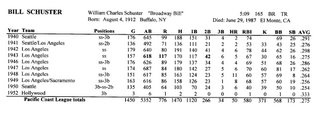Books I’ve Read Over the Winter, and Into the Spring, Part TwoI have to admit, this is one book for which I’ve been waiting. Barry Swanton’s
Mandak League: Haven for Former Negro League Ballplayers, 1950-1957 does not disappoint. A McFarland book (which can be ordered from Amazon, where I got my copy), this history gives an overall view of that Western Canada league in all its glory, and in all its failed promise near the end. Length: 222 pages and $29.95 soft cover (from Amazon, and qualifies for free shipping from them:
http://www.amazon.com/gp/product/0786425105/102-4552237-4141736?v=glance&n=283155The Mandak League began as an outgrowth of the Manitoba Senior League. The previous league would import up to three players per roster, many of whom were veterans of the Negro Leagues. The Manitoba-Dakota League was formed to ride the wave of interest in minor league ball after the Second World War. That golden age lasted from 1946 through 1952 or 1953, when baseball began a long decline in attendance. Swanton’s book chronicles the highs and the decline for the Mandak League.
Because the league had a very high salary cap of $8,500, it was able to attract veteran black players who could no longer be considered “prospects” by major league clubs, and attracted O. B. players with the same futures as the black veteran players.
The league began as a five-club circuit in 1950, but became a four-team league in 1951, and remained so until its demise after the 1957 season. Winnipeg was the hub of the league (with two clubs its first season), but after the 1953 it joined the rival Northern League in Organized Baseball. In 1955, Bismarck, North Dakota joined the league to partially offset the loss of Winnipeg.
The book is set out chronologically, with season-by-season recaps. The 1950 season goes into detail on the ballparks, the league personnel and umpires, then relates the pennant race, season highlights and any in-season tournaments played. The following season chapters give pennant-race recaps, highlights and playoff summaries.
All the season chapters are well constructed, well written, and hold the reader’s interest. What also helps is that Swanton’s second section of the book gives player profiles of most of the players in the league, making it easy to flip to when one is reading the first section of the book.
As to the player profiles, let me give you an example that I just now flipped to:
Lou Lombardo
Pitcher; Bats—Left; Throws—Left; Height—6’2; Weight— 210 lbs;
Born— November 18, 1928 in Carlstadt, New Jersey; Died— June 11, 2001 in Rock Hill, South Carolina.
Lombardo was 20 years old when he appeared in two games for the New York Giants in 1948. He pitched five innings and had a 6.75 ERA. In 1950, he pitched in Double-A with Little Rock in the Southern Association. In 1952, he was 11-3 for Montgomery in the Sally League. In 1953, he was 25 years old when he joined the Minot Mallards from Rochester, Minnesota of the Southern Minny (semi-pro) . He pitched six games with little success and had an 0-3 record when he was released on July 16.
After the comprehensive player profiles, Swanton has three appendices (strangely numbered: I, II, and IV, and even though I took what was called poet’s math at Columbia, I can still find my way to Super IV without much brain sweat).
The first appendix is a one-page reprint of the 1950 Minot Mallard team rules, which may or may not be of much interest.
Appendix II is the most important part of the book for me, and for many others. This appendix lists batting and pitching stats for most players, reunited (apparently) from a number of primary sources. In 1950, batting stats included are for:
G AB H HR RBI AVG Pitching: W L Pct.
From 1952 on, batting stats include DB & TR. Pitching remains light throughout, but does include Strikeouts and Walks in later seasons.
In another nice feature, Swanton list players for whom no statistic are available.
The final appendix (IV) list complete rosters for each franchise, season by season, with notes on players who appeared for other clubs in the league during the season.
In conclusion, I can’t recommend this book enough. It belongs on every minor league researcher’s bookshelf.















